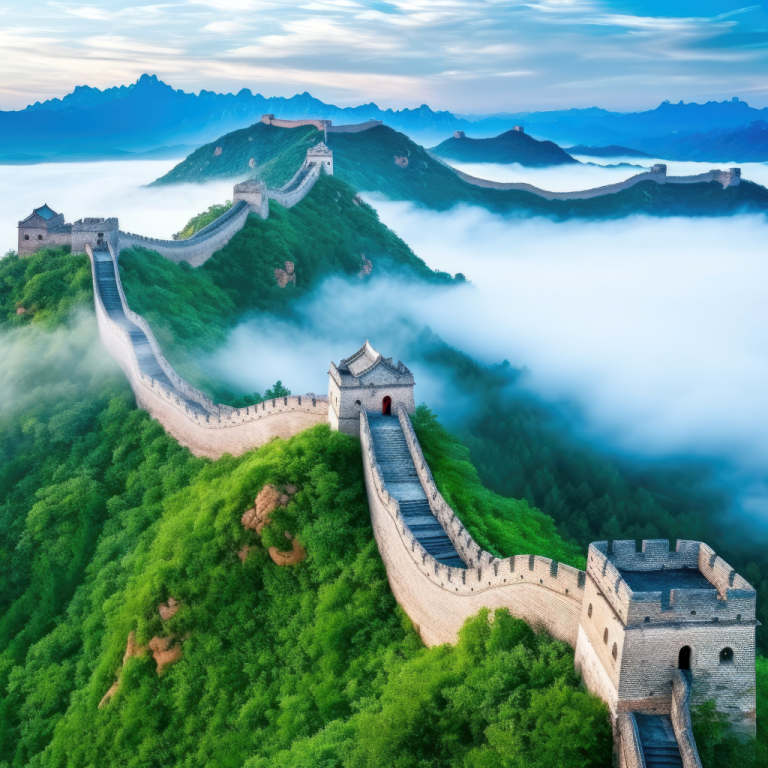The Great Wall of China is more than just a wall; it is a testament to human ingenuity, perseverance, and the desire for security and peace. Stretching over 13,000 miles, this colossal structure meanders through deserts, mountains, and plateaus, reflecting the long and tumultuous history of China. It is one of the most iconic symbols of China and a marvel of ancient engineering.
Historical Background
The history of the Great Wall dates back to the 7th century BC during the Warring States period. Initially, various feudal states constructed walls for defense against nomadic invasions. It was during the Qin Dynasty (221-206 BC) that these walls were unified under Emperor Qin Shi Huang. He connected and extended the existing walls to protect the northern borders of the newly unified China from the Xiongnu tribes.
The wall we most commonly associate with today was built much later, during the Ming Dynasty (1368-1644 AD). The Ming emperors, faced with constant threats from the Mongols and other tribes, invested heavily in fortifying and extending the wall. This period saw the construction of most of the well-preserved sections of the wall that tourists visit today.
Construction and Architecture
The construction of the Great Wall was an immense and arduous task. It involved millions of workers, including soldiers, peasants, and prisoners. The materials used varied depending on the geographical location. In the mountains, locally sourced stone was used, while in the plains, rammed earth and bricks were more common.
The wall is not a continuous line but a series of walls and fortifications, including watchtowers, barracks, garrison stations, and signaling towers. These structures played crucial roles in defense, allowing soldiers to keep watch for invaders, store supplies, and communicate across vast distances using smoke signals by day and fire by night.
Cultural Significance
The Great Wall is more than a military fortification; it is a cultural icon. It has been a source of inspiration for countless poets, writers, and artists over centuries. The wall symbolizes the strength and resilience of the Chinese people and their enduring spirit to overcome challenges.
Moreover, it represents a significant chapter in China’s history, illustrating the lengths to which ancient Chinese civilizations went to protect their land and culture. Today, the Great Wall is a UNESCO World Heritage Site and attracts millions of visitors from around the world, eager to witness this monumental achievement.
Myths and Legends
The Great Wall is steeped in myths and legends. One of the most famous is the story of Meng Jiangnü, whose husband was conscripted to work on the wall. According to the legend, he died due to the harsh conditions, and Meng Jiangnü’s tears caused a section of the wall to collapse, revealing his bones. This tale highlights the human cost and suffering that went into building the wall.
Another myth is that the Great Wall is visible from space with the naked eye. While it is a massive structure, this claim has been debunked by astronauts and scientists. The wall is indeed long but relatively narrow and blends into the natural landscape, making it difficult to see without aid.
Preservation and Challenges
Preserving the Great Wall is a complex and ongoing challenge. Natural erosion, human activities, and the sheer length of the wall make conservation efforts difficult. Some sections of the wall are in excellent condition, while others have deteriorated significantly.
In recent years, there has been a growing awareness and effort to protect and restore the wall. The Chinese government, along with various international organizations, has implemented measures to preserve this historic monument for future generations.
Conclusion
The Great Wall of China stands as a monumental achievement in human history. It is a symbol of China’s rich cultural heritage, reflecting centuries of resilience, strategy, and engineering prowess. Visiting the Great Wall offers not only a glimpse into China’s past but also an appreciation of the collective effort that went into creating this world wonder. Whether you view it as a military fortification, a cultural icon, or a historical artifact, the Great Wall of China continues to captivate and inspire people from all over the globe.






